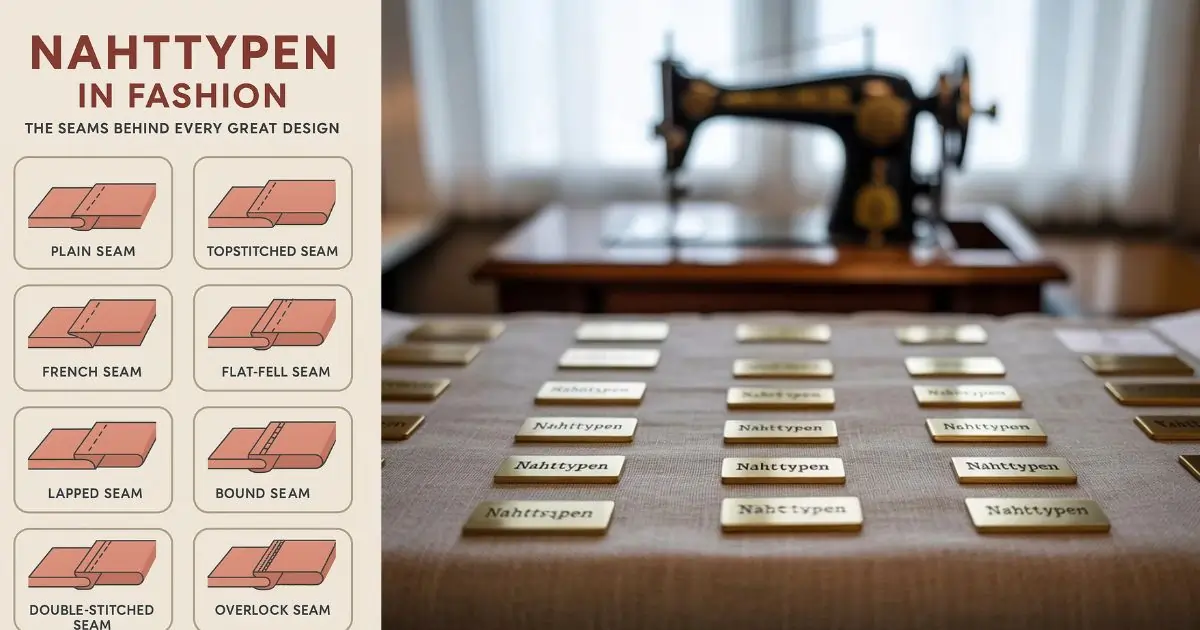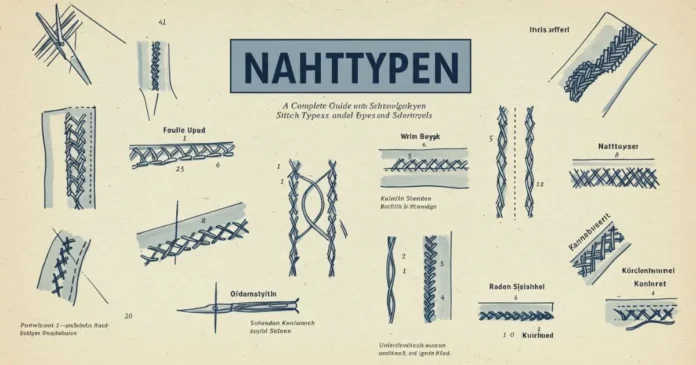In sewing and garment construction, seams are the hidden heroes that hold everything together. In German, the term Nahttypen means “types of seams” — and understanding them is crucial for creating durable, stylish, and well-finished garments.
Whether you’re designing high-end fashion, home textiles, or simply learning to sew, each Nahttyp (seam type) serves a specific purpose. From strength and flexibility to aesthetics and function, the right seam makes all the difference.
In this detailed guide, you’ll learn what Nahttypen are, the most common seam types used in clothing and textiles, when to use each one, and how they influence garment quality and performance.
What Are Nahttypen?
The German word Nahttypen translates to “types of seams” in English. In the world of textiles, a seam is the line where stitches join two pieces of fabric. Different seam types serve different purposes—some are strong and durable, others are decorative or used for delicate fabrics.

Understanding Nahttypen is important because:
- They impact the fit and function of garments
- They determine aesthetic finish and durability
- Some seams are better for stretch fabrics, others for stiff materials
- Industrial and couture sewing rely on different seam choices
Whether you’re a beginner or a seasoned tailor, knowing your seam types helps you make garments that are more comfortable, long-lasting, and professionally finished.
Why Seam Types Matter in Sewing
Choosing the right Nahttyp (seam type) matters for several reasons:
| Purpose | Impact |
| Strength | Seams hold garments together; weak seams tear easily |
| Stretch & Flexibility | Some seams allow stretch, others do not |
| Fabric Compatibility | Heavy vs light, woven vs knit fabrics need different seams |
| Aesthetic Finish | Visible seams should look clean and consistent |
| Durability | Flat-felled or bound seams resist fraying and wear |
| Functionality | Waterproof seams (e.g., for outdoor wear) require special finishes |
Fun Fact: High-end fashion brands use multiple Nahttypen in a single garment to balance style and strength.
Common Types of Nahttypen (Seams)
Here’s a detailed look at the most common seam types used in fashion, tailoring, and home sewing. Each seam has its pros, cons, and best uses.
1. Geradstichnaht (Plain Seam)
🔹 English: Plain Seam
Best for: Everyday clothing, cotton, woven fabrics
Machine: Straight stitch machine
The Geradstichnaht is the most fundamental seam type. It joins two pieces of fabric using a straight stitch, typically with a seam allowance of 1 cm or more.
After sewing, the raw edges must be:
- Finished with a zigzag stitch
- Trimmed with pinking shears
- Or finished using an overlock machine
🧵 Important Distinction:
Using an overlock stitch to finish the raw edges of a plain seam is different from sewing a true Overlocknaht (which joins two fabrics in one pass using a serger).
✅ Pros: Easy, quick, suitable for most garments
❌ Cons: Needs edge finishing for long-term durability
2. Französische Naht (French Seam)
🔹 English: French Seam
Best for: Sheer, lightweight, or delicate fabrics (e.g., chiffon, silk)
Machine: Straight stitch machine (2 passes)
The Französische Naht is a clean, enclosed seam where raw edges are hidden inside a folded seam. It’s ideal for garments where the inside is visible, like blouses or lingerie.
✨ Process:
- Sew the wrong sides together with a narrow seam
- Trim the edge, press
- Fold right sides together, sew again to encase raw edges
✅ Pros: Elegant finish, prevents fraying
❌ Cons: Not suitable for thick or heavy fabrics
3. Kappnaht (Flat-Felled Seam)
🔹 English: Flat-Felled Seam
Best for: Jeans, sportswear, workwear
Machine: Regular or industrial flat-feller
Kappnaht is one of the strongest seams. It involves folding one seam allowance over the other and stitching it flat to fully enclose both raw edges.
🧵 Used for areas under tension, like:
- Inseams of jeans
- Side seams of uniforms
- Outdoor wear (waterproof variants)
✅ Pros: Durable, fray-proof, professional finish
❌ Cons: Time-consuming, adds thickness
4. Overlocknaht (Overlock Seam)
🔹 English: Overlock or Serger Seam
Best for: Knit fabrics, stretch garments
Machine: Overlock machine (serger)
The Overlocknaht is sewn using a specialized serger machine that trims the fabric, sews the seam, and finishes the edge — all in one go.
🧵 Use Cases:
- T-shirts
- Leggings
- Activewear
- Knit dresses
🎯 Clarification:
Using an overlock machine to finish the edge of a plain seam is not the same as constructing an Overlocknaht, which is a fully functional seam on its own. The latter is structurally integral, especially in knit garments.
✅ Pros: Stretchy, clean, efficient
❌ Cons: Requires a serger, not ideal for woven fabrics
5. Zickzacknaht (Zigzag Seam)
🔹 English: Zigzag Seam
Best for: Lightweight knits, edge finishing
Machine: Regular sewing machine with zigzag function
The Zickzacknaht is versatile for:
- Reinforcing seam allowances
- Adding stretch to straight seams
- Applying decorative finishes
- Hemming elastic garments
🧵 Often used by home sewers without access to a serger.
✅ Pros: Stretchy, widely accessible
❌ Cons: Less polished than serger seams
6. Bindenaht (Bound Seam)
🔹 English: Bound Seam
Best for: Coats, jackets, bags, unlined garments
Machine: Regular with binding foot or manual bias binding
Bindenaht encloses seam allowances in fabric strips (usually bias tape), which can:
- Protect edges from fraying
- Add a pop of contrast color
- Create a couture-style finish
✅ Pros: Stylish, strong
❌ Cons: Requires extra materials and time
📐 Seam Comparison Chart
| Seam Type (Nahttyp) | Fabric Suitability | Strength | Stretch | Clean Finish | Tools Needed |
| Plain (Geradstichnaht) | Woven | ⭐⭐ | ❌ | ✅ (if finished) | Standard machine |
| French (Französische) | Lightweight | ⭐⭐⭐ | ❌ | ✅✅ | Standard machine |
| Flat-Felled (Kappnaht) | Heavy | ⭐⭐⭐⭐ | ❌ | ✅✅✅ | Standard/industrial |
| Overlock (Overlocknaht) | Knit/stretch | ⭐⭐⭐ | ✅✅✅ | ✅✅✅ | Serger |
| Zigzag (Zickzacknaht) | Stretch/light | ⭐⭐ | ✅✅ | ✅ | Standard machine |
| Bound (Bindenaht) | Mid to heavy | ⭐⭐⭐ | ❌ | ✅✅ | Binding foot |
Nahttypen in Industrial vs Home Sewing
In industrial sewing, the right Nahttyp is chosen to match:
- Production speed
- Cost-efficiency
- Garment category (activewear, suits, denim)
In-home sewing, flexibility, and aesthetics matter more:
- Home sewers often use French seams or zigzags as alternatives to industrial equipment.
- Sergers and coverstitch machines bring industrial results to the home.
Pro Tip: Mixing it in one garment improves both structure and design.
Nahttypen by Fabric Type
| Fabric Type | Recommended Seam |
| Cotton | Plain seam + zigzag or overlock |
| Silk/Chiffon | French seam |
| Denim/Canvas | Flat-felled seam |
| Knit/Jersey | Overlock or zigzag |
| Fleece/Stretch | Overlock + reinforced stitching |
Who Should Learn Nahttypen?
Understanding seam types is essential for:
- Fashion design students
- Textile engineers
- Costume designers
- Home sewers and hobbyists
- Garment manufacturers
Knowing which Nahttyp to use is as important as choosing the right fabric or pattern.
FAQs
Q1: What is the strongest seam type?
Flat-felled seams (Kappnaht) are among the strongest, used in jeans and uniforms.
Q2: What is the best seam for silk?
French seams are ideal for silk and delicate fabrics due to their enclosed finish.
Q3: Can I make professional seams without an overlocker?
Yes—use French seams, zigzag, or bias-bound seams for clean results.
Q4: What Nahttypen are used in sportswear?
Overlock seams with reinforced topstitching are common for stretch and durability.
Q5: Are Nahttypen taught in fashion schools?
Absolutely—understanding seam types is part of pattern making, sewing construction, and garment technology courses.
Final Thoughts
Whether you’re crafting a handmade blouse or designing a sports jacket, understanding Nahttypen gives you control over your sewing results.
The right seam:
- Improves garment strength
- Enhances visual appeal
- Ensures comfort and fit
- Adds durability and value
By learning seam types like French seams, flat-felled seams, or overlocks, you’ll take your sewing projects to a professional level.
Also Read:

